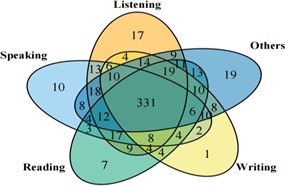Action Research on English Demand in Vocational Undergraduate Education
Abstract
Vocational undergraduate education is a new field for cultivating high-level and highly skilled vocational and technical talents. The integration of professional and vocational aspects is an important approach to cultivating "high-end" talents in vocational undergraduate education. However, there are problems in the actual teaching of vocational undergraduate colleges. Taking English teaching as an example, the existing textbooks, talent cultivation plans, and classroom teaching management models cannot meet the English learning needs of students or the demands of society for the English discipline in vocational education. As a result, most students are disconnected from classroom teaching, or they are not interested in English learning, and even give up learning English. In response to this practical problem, the author collected relevant data on English needs in the only vocational undergraduate university in Hainan Province and explored the reform path of English courses in vocational undergraduate colleges from three aspects: students' own needs, social needs, and teaching management.
References
[2] Li, R. (n.d.). Investigation and analysis on the teaching of college English courses for finance and economics in higher vocational colleges based on social and learning demands: A case study of Guangxi Yinghua. Guangxi Education, (3), 126–129.
[3] Ma, C., & Wang, W. (n.d.). Discussion on the reform of higher vocational English teaching under the guidance of "Higher Vocational Education College English Curriculum Standards (2021 Edition)". Growing, (9), 150.
[4] The Chinese Government's Official Website. (2022, April 21). The Vocational Education Law of the People's Republic of China. http://www.gov.cn/xinwen/2022-04/21/content_5686375.html
[5] Cai, J. (2017). Reflections on 40 Years of English Education in Chinese Universities: Failures and Lessons. Journal of Northeast Normal University (Philosophy and Social Sciences Edition), (5), 1–7.
[6] Ministry of Education of the People's Republic of China. (2010). National Medium and Long-Term Education Reform and Development Plan Outline (2010-2020). http://www.moe.gov.cn/jyb_xwfb/s6052/moe_838/201008/t20100802_93704.html
[7] Brown, J. D. (2016). Introducing Needs Analysis and English for Specific Purposes. Routledge. https://doi.org/10.4324/9781315671390
[8] Chen, B. (2009). Review of foreign demand analysis studies. Foreign Language Teaching and Research, 41(2), 125–130.
[9] Zeng, J., Hu, S., & Huang, Y. (2013). Analysis of academic English requirements for graduate students. China University Teaching, (10), 79–83.
[10] Hutchinson, T., & Waters, A. (1987). English for specific purposes. Shanghai Foreign Language Education Press. https://doi.org/10.1016/0889-4906(87)90071-8
[11] Jordan, R. R. (1997). English for academic purposes: A guide and resource book for teacher. Cambridge University Press. https://doi.org/10.1017/CBO9780511733062
[12] Dudley, E. T., & St. John, M. J. (1998). Developments in English for specific purposes: A multi-disciplinary approach. Cambridge University Press.
[13] Shu, D. (2004). Foreign language teaching reform: Problems and solutions. Shanghai Foreign Language Education Press.
[14] Wang, H. (2004). Analysis of requirements and conditions in the design of personalized college English teaching schedules. Chinese Foreign Language, (1).
[15] Chen, B. (2010). Theoretical construction of the university English demand analysis model. Foreign Language Research, (2), 120–123.
[16] Ji, Q., et al. (2024). Construction and validation of a learning needs model for curriculum-based political and virtuous awareness education in college English courses. Technology Enhanced Foreign Language Education, (1), 59–69.
[17] Wiersma, W., & Jurs, S. G. (2010). Introduction to educational research methods (9th ed.). Education Science Press.


This work is licensed under a Creative Commons Attribution 4.0 International License.
Copyright for this article is retained by the author(s), with first publication rights granted to the journal.
This is an open-access article distributed under the terms and conditions of the Creative Commons Attribution license (http://creativecommons.org/licenses/by/4.0/).








1.png)

















